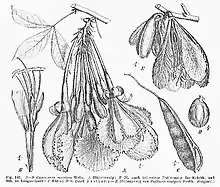Camoensia (plant)
Camoensia is a genus of 2 species of lianas in the family Fabaceae, subfamily Faboideae, native to the Gulf of Guinea, Africa. C. scandens is cultivated as an ornamental plant; it has one of the largest leguminous flowers, up to 20 cm across.[5] The genus has classically been assigned to the tribe Sophoreae,[6] but was recently assigned to its own monophyletic tribe, Camoensieae, on the basis of molecular phylogenetic evidence.[1][2][7][8] Species of Camoensia are known to produce quinolizidine alkaloids, consistent with their placement in the genistoid clade.[6][9]
| Camoensia | |
|---|---|
 | |
| Camoensia scandens: illustrations A-D | |
| Scientific classification | |
| Kingdom: | Plantae |
| Clade: | Tracheophytes |
| Clade: | Angiosperms |
| Clade: | Eudicots |
| Clade: | Rosids |
| Order: | Fabales |
| Family: | Fabaceae |
| Subfamily: | Faboideae |
| Clade: | Meso-Papilionoideae |
| Clade: | Genistoids |
| Tribe: | Camoensieae (Yakovlev 1972) Cardoso et al. 2013.[1][2] |
| Genus: | Camoensia Welw. ex Benth. & Hook. f. |
| Species[3][4] | |
| |
| Synonyms | |
| |
Gallery
.jpg.webp) Colour plate depicting Camoensia sp.
Colour plate depicting Camoensia sp._(17497773833).jpg.webp) Black and white image of C. scandens (syn. C. maxima)
Black and white image of C. scandens (syn. C. maxima)_b_730.jpg.webp) Botanical line drawing from Die Gartenlaube (1883)
Botanical line drawing from Die Gartenlaube (1883)
References
- Cardoso D, Pennington RT, de Queiroz LP, Boatwright JS, Van Wyk BE, Wojciechowski MF, Lavin M (2013). "Reconstructing the deep-branching relationships of the papilionoid legumes". S Afr J Bot. 89: 58–75. doi:10.1016/j.sajb.2013.05.001.
- Wojciechowski MF (2013). "Towards a new classification of Leguminosae: Naming clades using non-Linnaean phylogenetic nomenclature". S Afr J Bot. 89: 85–93. doi:10.1016/j.sajb.2013.06.017.
- "ILDIS LegumeWeb entry for Camoensia". International Legume Database & Information Service. Cardiff School of Computer Science & Informatics. Retrieved 12 February 2014.
- USDA; ARS; National Genetic Resources Program. "GRIN species records of Camoensia". Germplasm Resources Information Network—(GRIN) [Online Database]. National Germplasm Resources Laboratory, Beltsville, Maryland. Archived from the original on 24 September 2015. Retrieved 12 February 2014.
- Mabberley DJ (1997). The Plant-Book: A Portable Dictionary of Plants, their Classifications, and Uses (2nd ed.). Cambridge University Press, UK. pp. 858. ISBN 0-521-41421-0.
- Polhill RM (1981). "Sophoreae". In Polhill RM, Raven PH (eds.). Advances in Legume Systematics, Part 1. Royal Botanic Gardens, Kew. pp. 213–230. ISBN 9780855212247.
- Crisp MD, Gilmore S, Van Wyk BE (2000). "Molecular phylogeny of the genistoid tribes of papilionoid legumes". In Herendeen PS, Bruneau A (eds.). Advances in Legume Systematics, Part 9. Royal Botanic Gardens, Kew. pp. 249–276. ISBN 184246017X.
- Cardoso D, de Queiroz LP, Pennington RT, de Lima HC, Fonty É, Wojciechowski MF, Lavin M (2012). "Revisiting the phylogeny of papilionoid legumes: new insights from comprehensively sampled early-branching lineages". Am J Bot. 99 (12): 1991–2013. doi:10.3732/ajb.1200380. PMID 23221500.
- Waterman PG, Faulkner DF (1982). "Quinolizidine/indolizidine alkaloids from the seed of Camoensia brevicalyx". Phytochemistry. 21: 215–218. doi:10.1016/0031-9422(82)80046-0.
 Data related to Camoensia (Fabaceae) at Wikispecies
Data related to Camoensia (Fabaceae) at Wikispecies Media related to Camoensia at Wikimedia Commons
Media related to Camoensia at Wikimedia Commons
This article is issued from Wikipedia. The text is licensed under Creative Commons - Attribution - Sharealike. Additional terms may apply for the media files.